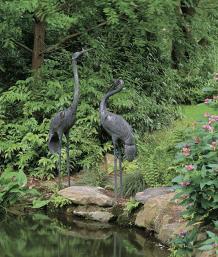
I love to embellish—my clothing, my house, and best of all, my garden. My first garden ornament, a beautiful copper owl, actually spent 12 years flying from coffee table to coffee table, as I repeatedly pronounced, “Someday, my friend, you will ornament my garden,” a garden I had yet to create. When we did find land, and I began building the bones of the landscape, my special owl found its first outdoor home on a boulder near a terrace, only to move one year later to a newly created herb garden, and then to a pond edge, and finally, to a sunken knot garden. Somehow, my ornaments never do find permanent homes—my owl has been quite happy flying from one perch to another.
Our latest move has been into an area rich in gardening history. We bought a house situated in the middle of a 214-acre overgrown orchard with the idea that I would surrender my 18-year career in science to the challenge of growing green plants outdoors. Living near Longwood Gardens, I enrolled in its two-year program in ornamental horticulture, hoping to learn just what plants I could grow in this area and how to integrate them into the landscape. As a result, my love of gardening mushroomed into an obsession. And with it grew my desire to embellish what I had grown.
Nature inspires creativity
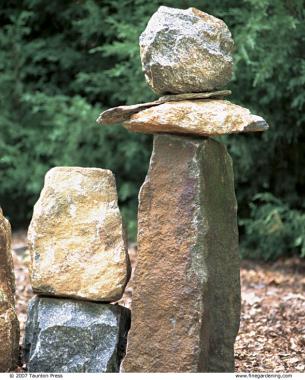
First we cleared our sloping landscape of its old fallen fruit trees, poison ivy, and multiflora roses. Rocks dominated the land, with many large outcroppings as well as mounds of smaller ones cast by farmers into the bordering hedgerow. The art of rock rearranging soon became an obsession with my husband, Per. Using winches and come-alongs, he moved boulders into artistic groupings, and rearranged them as terracing retainers and as low walls weaving through the landscape. He used rocks to depict stories, and even levitated some into the arms of a pollarded cherry. Along with rock works, Per created five ponds: two terrace pools behind our house, a double pond nestled among large boulders on the hillside, a pool at the edge of a knot garden, and finally a large woodland pond anchored by a gazebo. And with water to play with, we brought statuary into the garden in the form of fountains. Frogs naturally populated our water gardens, and eventually they became a recurrent theme for ornament throughout the garden.
The garden has been developing and growing for more than 15 years. A series of island plantings and gardens, each individual unto themselves yet integrated into the overall design, forms the basis of the landscape. The garden is an informal one: no straight lines, no formal hedges, save the knot garden. It is filled with both woody and herbaceous plants. I am a plant lover and a collector of all green things that are rare and unusual. I design with color, texture, form, and contrast in mind. As I developed each specific area of the garden, I introduced a touch of whimsy by adding unusual ornaments. I create the gardens to make people smile.
Themes create continuity
To incorporate my love of ornament into the garden, I soon realized that I needed themes to create a sense of continuity. I already had the rocks and water, a statuary collection centered around frogs and birds, sitting spaces carved into the landscape, and tropical plants summering outdoors in containers. By building on these specific themes, I relaxed and didn’t worry about following traditional rules of ornament use in the garden. Whose rules are they, anyway? I was having a grand time, and that’s what mattered most.
I find water is a most pleasing and soothing element in the garden. Still water is calming—it reflects the sky as well as silhouettes of limbs overhead. Moving water is cooling, and a splashing fountain supplies music to its surroundings. We try to keep it simple— too much noise or movement is jarring to the eyes as well as to the ears. With water comes a host of living creatures—frogs, fish, birds, dragonflies, turtles, snakes, and water striders. Each pond lends itself to further embellishment: Bronze herons stand at the edge of a clump of pickerel weed (Pontederia cordata), and rusty metal birds perch near a stone wall, interplanted with Christmas ferns (Polystichum acrostichoides), hardy begonia (Begonia grandis), Japanese primroses (Primula japonica), and lots of moss (perfect sitting pads for the live frogs).
A bird motif creates a sense of unity
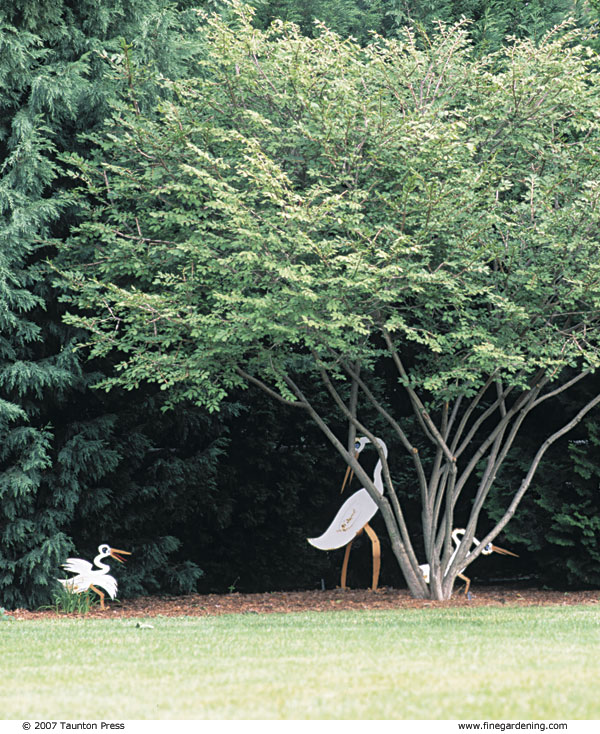

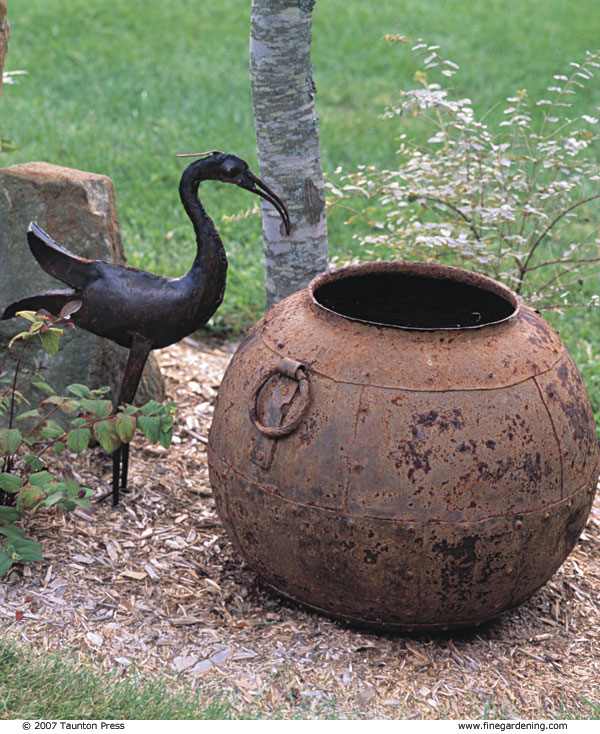
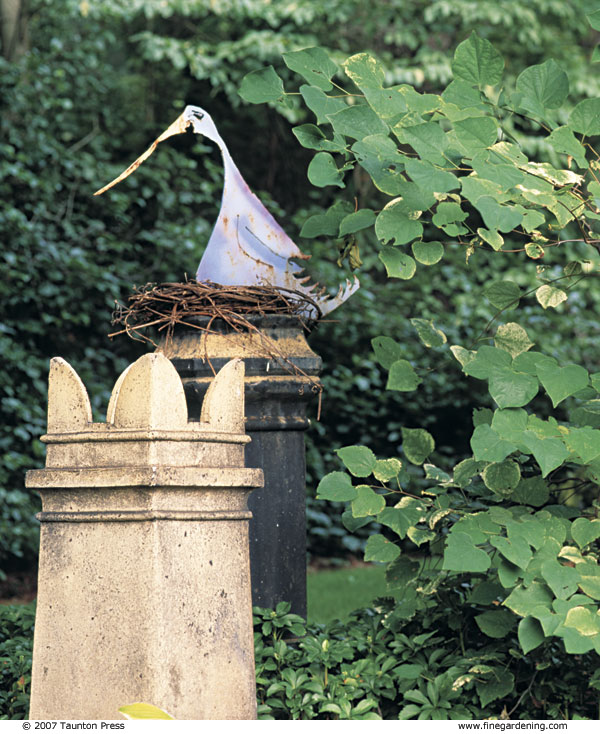
By developing motifs, the author creates a sense of unity in the garden. Wild, wonderful, and wacky birds add a whimsical and lighthearted tone. Further interest is created by partially hiding a bird from view so that it can be discovered (bottom right photo), by choosing rusty metal objects that blend naturally with the landscape (bottom left), by positioning a striding ostrich in the middle of an open expanse so it can be seen from far away (top right), and by grouping similar objects together, like this family of storks dancing around a tree (top left).
Ornament adds a lighthearted note
For me, an informal garden demands art that is fun rather than serious. The types of art I collect and create allow me to personalize the garden. I set a tone of lightheartedness, and when I enter the green space I feel instantly cheered and entertained. Even whimsical ornament, however, can serve purposeful design functions. It can be used as an anchor, giving a sense of solidity to an area, as a focal point to draw you into or through the garden, or as a complement to the texture and color of plants.
I rarely buy or create ornaments for a specific spot. One ornament came into the garden on my lap via an 18-hour plane ride from Japan because it spoke to me and just had to be part of my growing space. Others were plucked from dusty benches at the local flea market or fashioned from nature’s abundance (an old, twining vine turned into a snake with the help of some copper eyes and fangs).
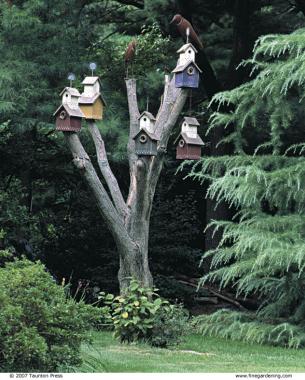
I have a few favorite artisans whose work I have collected over the years. Bill Heise, from Vermont, is a creator of found-metal sculpture. I have a marvelous collection of his birds—bitterns, secretaries, herons, and sandpipers. An artist from Pennsylvania who is simply named Simple uses a laser torch to cut out two-dimensional iron objects ranging in size from 2 to 5 feet. I have collected a series of his birds, painted in bold colors. I use them as focal points in the landscape, and I love to plant colorful gardens around them. Three bright-blue herons with magenta heads and yellow bills are surrounded by rosy-purple smoke bush (Cotinus coggygria ‘Velvet Cloak’), brilliant yellow golden creeping Jenny (Lysimachia nummularia ‘Aurea’), and the bright-pink blooms of hydrangea (Hydrangea macrophylla ‘Pia’).
I also think of furniture as ornament in the garden because it can be as beautiful to look at as it is functional. I use it not only on the terraces or in groupings beside the large pond, but also by associating it with either secret hideaways or open vistas. By carefully limbing up trees and tucking in chairs and tables, I have spots to wind down my gardening day with a well-earned bottle of cold beer. Shafts of late-day sunlight squeeze through the trees as I watch a busy wren building her nest—ah, pure delight. Or I place a bench at the start of a long vista, and many a morning I sip coffee there, smelling the garden and savoring the view. Weathered teak and cedar are the furniture materials of choice, blending nicely into the landscape.
Pots show off tropical plants
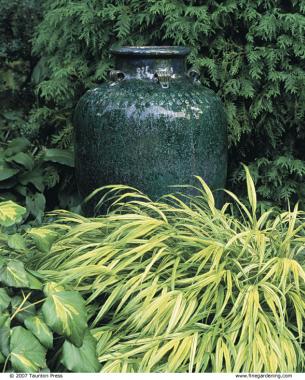
I display a collection of urns; some are empty and others are filled with tender perennials and tropicals. The containers are either unglazed terra-cotta from Italy and Mexico or a single-color glazed clay from Southeast Asia. I use many containers (about 130), and try to make them harmonize with one another in shape, size, and color. The ones filled with plantings are placed on two terraces, where they complement the hard, straight lines of bricks. The containers add a splash of color on a terrace in a sunny location and a lushness of cool green to a shady terrace. I use them in groups of three, five, or more, adding height to the display with pedestals.
A selection of old Turkish jars filled with Echeveria, Agave, and Gasteria species adorn the edge of the rectangular pond by the knot garden. They clearly help soften the look of the hardscaping. Elsewhere, unplanted urns—large Turkish oil jars or terracotta African vessels—find spots next to plantings of irises or grasses and in a border of mixed shrubs.
More photos from Eve Thyrum’s garden
Keep it all in good taste
How do you incorporate 140 pieces of sculpture; 15 groupings of furniture; 42 birdhouses, feeders, and birdbaths; 15 urns; and 130 potted containers into a 2-acre landscape? There is a fine line between tasteful and tacky, and I try constantly not to overstep this boundary.
Part of the secret is to keep things simple. I usually place art singly, as an enhancement or complement to the surrounding garden space, though I will place ornaments in groups if they are of similar design, color, or material. I like to soften the edges of ornaments with plants to make them an integral part of the garden. Much of the artwork is made of rusty metal, a form that blends naturally into the landscape.
I also think about the element of spacing. I strive to site ornaments in interesting ways so visitors are either urged to move from one area of the garden to the next or given cause to pause. Surprises are fun, so I site statuary where it can be discovered, or I shield it from constant view, among foliage, around a corner, behind the viewer, or above. I place small frogs under hosta leaves, a striding ostrich on unmown lawn in the middle of a large expanse, a rusty opossum along a branch of a Chinese chestnut, and a leaping gazelle camouflaged behind spiky boulders.
I find the best use of ornament is sometimes unplanned-the blue flowers of Clematis X durandii peeking out from under the wing of a blue and yellow whimsical canary, or Asarina scandens, with its dainty snapdragonlike blooms, twining up and around the long leg of a rusting metal heron. I never assume that an ornament has been placed in a permanent and perfect spot. One of the great pleasures of a garden is that it grows, evolves, and changes. Moving ornaments to different locations keeps the garden dynamic and refreshing. Ask my owl.
Fine Gardening Recommended Products

A.M. Leonard Deluxe Soil Knife & Leather Sheath Combo
Fine Gardening receives a commission for items purchased through links on this site, including Amazon Associates and other affiliate advertising programs.

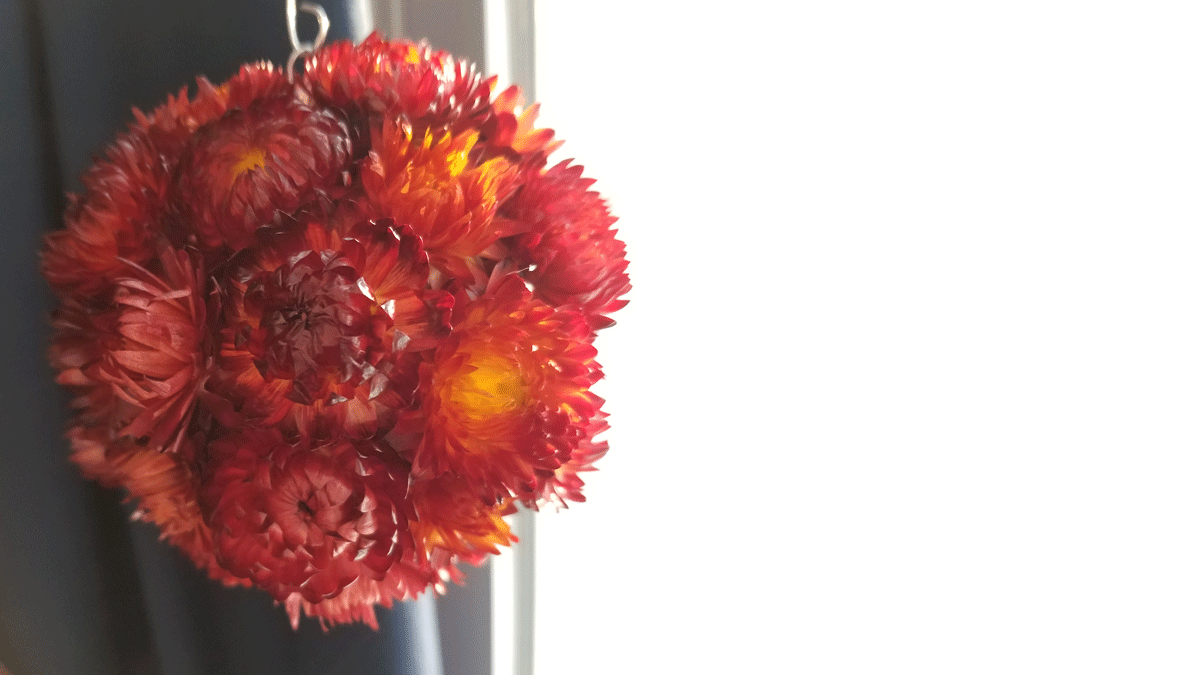
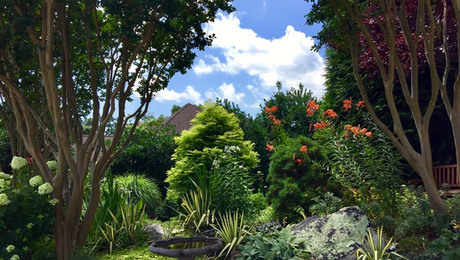
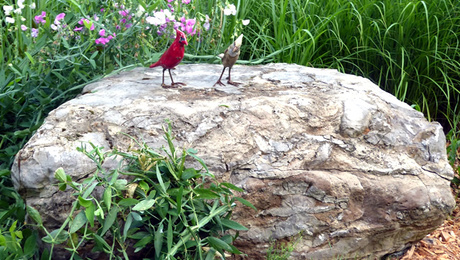
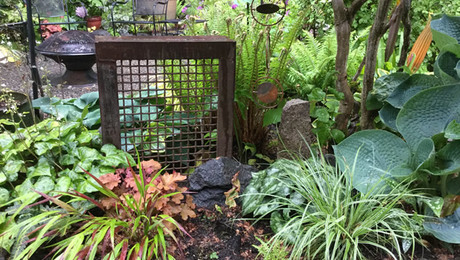

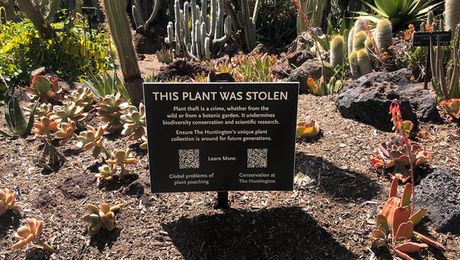











Comments
A wonderful informative article. I believe in art in the garden. Many Botanical Gardens near where I live are having actual changing exhibits. I like that this shows how to use the artful ornaments in a home garden. Thanks.
Log in or create an account to post a comment.
Sign up Log in